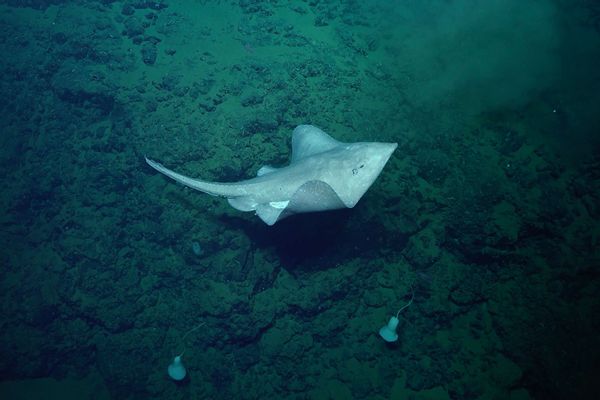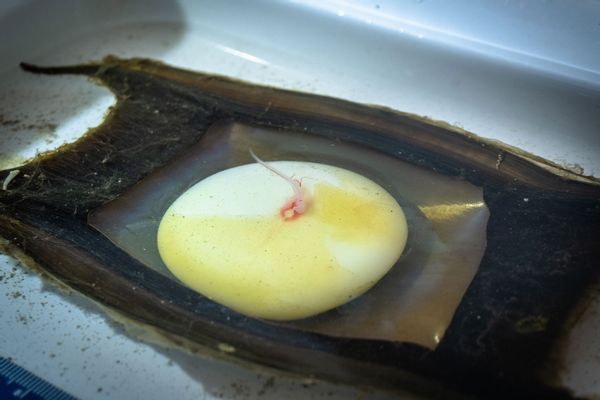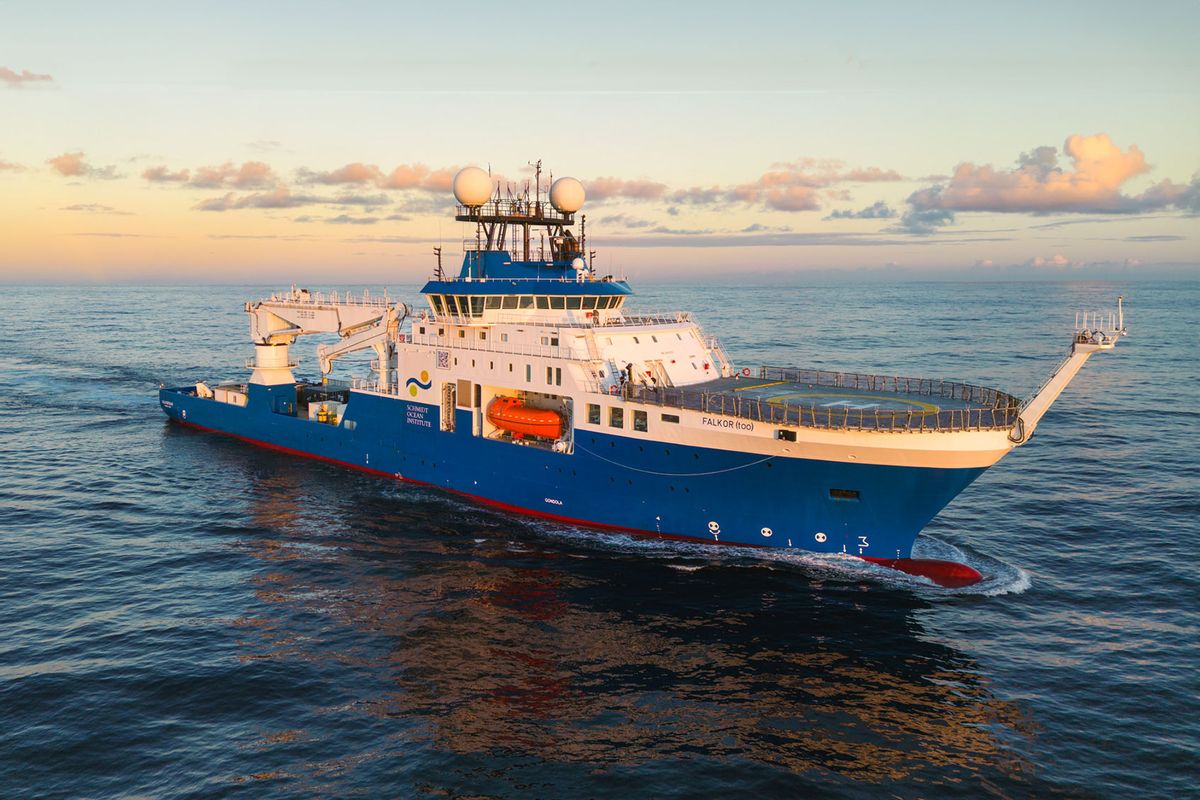Miles beneath the ocean's surface, a remotely-operated vehicle called SuBastian smoothly glided up the side of an underwater mountain near the coast of Costa Rica. The eerie glow it cast ahead revealed bubblegum-pink corals scattered here and there among greenish black rocks as a crew on a ship at the surface guided SuBastian along. An otherworldly scene awaited at the peak; a treasure trove of dark, leathery pouches lay nestled amid the rocks, resembling meticulously designed props for an episode of Star Trek.
Each of the hundred or so pouches, known as mermaid purses, is the temporary home of a baby deep-sea skate — a spade-shaped fish related to rays and, more distantly, sharks. Their flat, diamond-shaped bodies flanked with wavy, wing-like fins make skates easily recognizable denizens of the deep.
But, if they’re the species researchers think they are, fewer than 100 have ever been spotted worldwide. That makes this nursery even more interesting.
The skate nursery is a bonus, spotted by chance as the team was exploring a nearby area that had never been seen before.
“We had only seen about ten skates total during several dives when we stumbled on this area teeming with egg cases," said Beatriz Naranjo, a marine biologist at the University of Costa Rica, who participated in the expedition. The team collected a sample for dissection to see whether these eggs were empty cradles, like unfertilized chicken eggs at the grocery store. However, Naranjo says they saw yolk and embryo development, which means a new generation of baby skates is incubating now at the top of a mountain at the bottom of the ocean.
The serendipitous find marks the first time a deep-sea skate nursery has ever been identified in Costa Rican waters. Scientists aboard the Schmidt Ocean Institute’s Falkor (too) research vessel were conducting an expedition with the primary goal of studying an octopus nursery, where they saw deep-sea octopuses hatching along low-temperature hydrothermal vents. The skate nursery is a bonus, spotted by chance as the team was exploring a nearby area that had never been seen before. The discovery opens up new questions about why the skate eggs are clustered in this specific area.
 Skate (Schmidt Ocean Institute)
Skate (Schmidt Ocean Institute)
A water cycle beneath the waves
In addition to vents, where warm fluids seep up from cracks in the Earth, hydrothermal systems also include recharge zones — cooler areas where water flows down into the seafloor. The skate nursery is found on one such suspected cold seep; the underwater mountain is actually called the Tengosed Seamount (Spanish for “I am thirsty”) for that reason. But when they arrived, the temperature at the skate nursery was the same as surrounding waters.
“We deployed temperature sensors to test hypotheses about hydrothermal outflows and recharge sites,” said Sergio Cambronero, an assistant professor at Costa Rica's Universidad Nacional, who also participated in the expedition. “That will also help us see if the temperature on the seamount fluctuates regularly or if it has periodic hydrothermal activity, and all of that will help us find out why the skates were drawn here to deposit their eggs.” The team will collect the sensors when they return in December for part two of their voyage.
Want more health and science stories in your inbox? Subscribe to Salon's weekly newsletter Lab Notes.
Slow living
In the meantime, the scientists are back ashore while Falkor (too) completes other expeditions. They’re working to confirm the species found at the skate nursery, which they think is the Pacific White Skate (Bathyraja spinosissima). These creatures have adapted to withstand the extreme environment miles beneath the ocean’s surface.
All of that pressure means hard-won energy would be quickly spent if it weren’t for the creatures’ slow metabolisms.
Their eggs likely incubate for an extremely long time — more than four years, based on information from similar species. Lengthy incubation times are common among deep-sea creatures, partly because biological and chemical reactions are slower in cold environments. Their sluggish metabolisms help them conserve energy, which is difficult to come by in the dark, sparsely-populated deep.
Navigating near the seafloor would be like surface-dwellers hiking up a mountain with an extremely heavy pack. Beneath the surface, the weight of all the water overhead crushes down. All of that pressure means hard-won energy would be quickly spent if it weren’t for the creatures’ slow metabolisms.
 Skate egg (Schmidt Ocean Institute/S. Cambronero)
Skate egg (Schmidt Ocean Institute/S. Cambronero)
The extended incubation period that comes attached with that means eggs are left vulnerable for very long stretches. But some deep-sea skate moms may have found a way to speed up the process. By depositing eggs along warm hydrothermal vents, skates can accelerate embryo development. One such instance near the Galápagos Islands was reported in 2018, and could also be the case at the Tengosed Seamount nursery if it experiences periodic hydrothermal activity. We won’t know for sure until the researchers collect their sensors.
A delicate balance
Even once they hatch, deep-sea skates develop very slowly. Various species are known to take around 10 to 20 years to reach the point where they can reproduce. The leisurely pace of life in the deep sea means creatures and habitats there are slow to recover if harmed, whether by human activity or natural causes.
But the lack of information about this remote region makes it difficult to even establish a baseline population. According to NOAA, 80 percent of the ocean remains uncharted and unseen. And the discovery of the skate nursery highlights how little we know about some areas that have been mapped.
“We knew the seamounts here existed thanks to a previous mapping expedition,” said Cambronero. “But you can’t understand the biodiversity of the deep sea without going there and looking around.”
Seeing the ecosystem firsthand and documenting their findings will likely help scientists establish protections around Tengosed Seamount. The nursery grounds seem to be an important area for these skates, and few other such locations are now known. Since these elusive creatures are seldom seen, it makes sense to take special efforts to protect their young. Who knows how few of them remain?
Though the International Union for Conservation of Nature (IUCN) acknowledges that these skates are “known only from a few scattered records,” they listed the species’ conservation status as “least concern.”
The leisurely pace of life in the deep sea means creatures and habitats there are slow to recover if harmed, whether by human activity or natural causes.
Their rationale is that the skates aren’t commercially targeted or likely to be picked up accidentally as bycatch, since their habitat is so deep and rocky –– it would be hard to scoop them up even if anyone wanted to. But some scientists disagree with this justification, partly because fishing and deep sea mining are both expanding human influence into deeper waters across the globe. The problem could get even worse as shallower food stocks or coral reefs collapse.
“Deep-sea ecosystems can be harmed indirectly through human activities; fishing is not the only possible concern,” said Naranjo. “Garbage is increasingly found in deep waters, and microplastics are present all over the ocean, no matter how deep or how far away from the coast. And climate change affects the ocean down to the seafloor, changing living conditions there.”
If the skates are harmed, they would likely take a long time to rebound and there could be ripple effects that snowball into tidal waves.
We rely on the ocean for food, pharmaceuticals and much of the oxygen we breathe. It’s important for the global economy and even dampens the effects of climate change. This is not a resource we can afford to destroy, experts argue and when we discount the importance of some of its inhabitants, we may put the ocean’s health –– and our own survival –– at risk.
“We try to ensure that every species is reassessed at least every five to ten years, or sooner if there is a significant change in its situation, but this is dependent on funding and capacity,” said Janet Scott, a programme officer for the IUCN's Red List Unit. “If an assessment is more than ten years old, it remains in place but is flagged as ‘needs updating’ on the website, to alert users that it may be outdated.”
Just over a year from now, the Pacific White Skate will hit this 10-year mark. In the meantime, scientists are working to better understand the creature’s true conservation status.
In search of secrets
The surprise finding of the skate nursery underscores the need for further deep-sea exploration and research. Beyond learning more about the skates themselves –– their reproductive habits, population, vulnerability and interconnection with the ocean at large –– the discovery hints that vital habitats may lay shrouded from human eyes in far more regions across the abyss.
We need your help to stay independent
Scientists around the globe continue to survey the deep sea and drive new protections for the intricate, delicate world that lies beneath the ocean’s surface. Doing so, they tap into one of the most fundamental facets of humanity: curiosity.
We are wired to explore, to push farther than ever before, to see the unseen. We revel in the thrill of unveiling the universe’s secrets, pressing into new frontiers to discover new mysteries. Those frontiers are dwindling as more of the world is mapped and traveled, its secrets laid bare.
Perhaps that’s why unreachable realms, like distant planets and our own alien deep sea, are so captivating. We yearn to know what wonders lay beyond the edges of our understanding. Technology can bring us part way there; telescopes and remotely-operated vehicles offer windows into both the heavens and the watery underworld of the deep. But they leave gaps full of questions. Shining a light in the darkest reaches of Earth and space both satisfies our curiosity and ignites it.



Shares